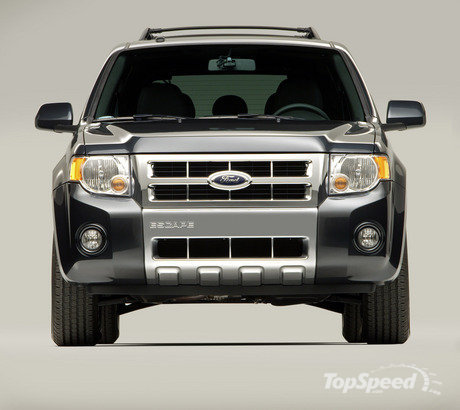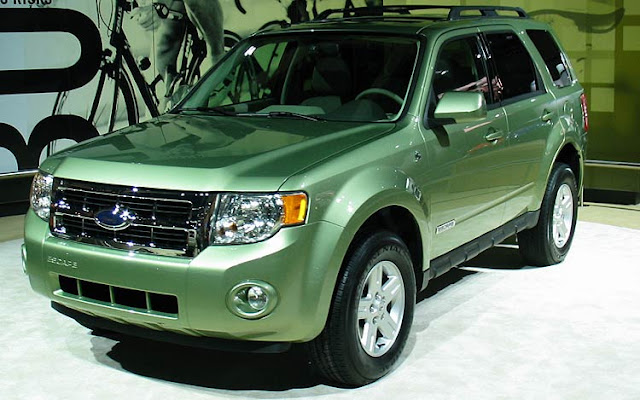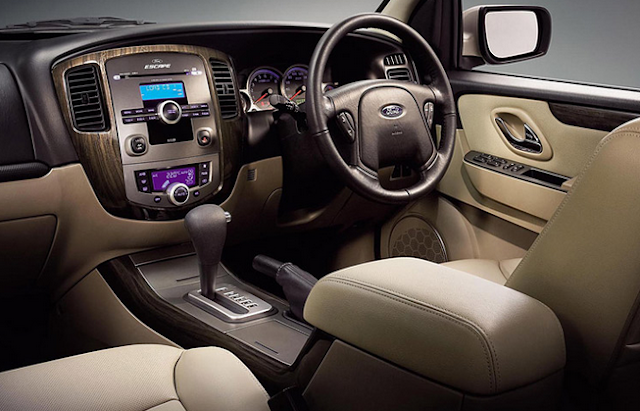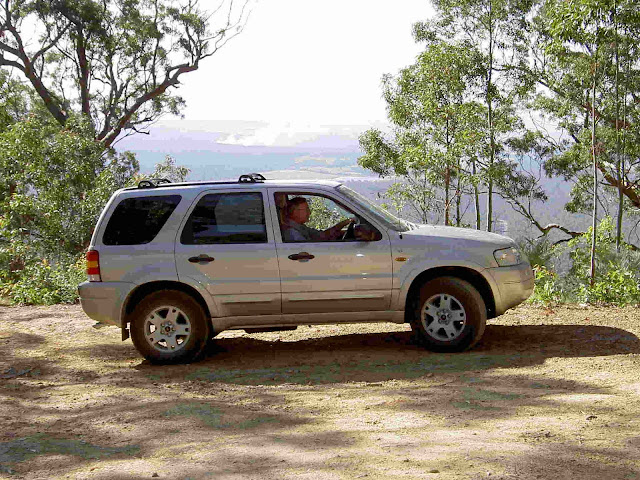Ford Escape Pictures
The Ford Escape is a compact SUV sold by the automaker Ford Motor Company introduced in 2000 as a 2001 model year and priced below the Ford Explorer. Although technically it's a crossover vehicle, it is marketed by Ford as part of its traditional SUV lineup (Escape, Explorer, Expedition) rather than its separate crossover lineup (Edge, Flex). The Escape was sold in Europe as the Ford Maverick. It was jointly developed with Mazda, in which Ford owned a controlling interest, and was released simultaneously with the Mazda Tribute. In the United States, Ford's Mercury division released a luxury version called the Mariner starting with the 2005 model year, but ended production in October 2010 as Ford ended the Mercury brand.
A hybrid version of the Escape was released in 2004, making it the first hybrid SUV.
The Escape is built on the Ford CD2 platform, which is in turn based on the Mazda GF platform, which was used by the Mazda 626. However, on June 23, 2010, it was announced that Ford will end production on the second generation Escape in 2011 and move production to its Louisville Assembly Plant in Louisville Kentucky, where it is slated to be succeeded by an American version of its European CUV counterpart, the Ford Kuga.
2010 Ford Escape Hybrid
The first generation Ford Escape was released in North America for the 2001 model year. It was slotted below the larger, truck-based Explorer in Ford's lineup, but was larger than the small SUV offerings from Honda and Toyota. At the time, most sport utility vehicles used a truck based Body-on-frame design. Solid rear axles were commonly used due to their ability to carry heavy loads at the expense of a comfortable ride and good handling. Ford realized that most initial SUV owners did not take their vehicles off road, and decided instead to use a car-like Monocoque design with a fully independent suspension and rack and pinion steering for the Escape. Although not meant for serious off-roading, a full time all wheel drive system supplied by Dana was optional which included a locking center differential activated by a switch on the dashboard. The all wheel drive system normally sends most of the power from the engine to the front wheels. If slipping is detected at the front, more power will be sent to the rear wheels in a fraction of a second. The entire braking system was built by Continental Teves including the ABS and various related suspension components. CKD production began in 2002 at Ford Lio Ho Motor Co. in Taiwan for various Asian markets.

Ford Escape Black
From 2001 to 2004 the Ford Escape was sold in Europe under the Maverick name, and replaced a rebadged version of the Nissan Mistral/Terrano II. Only two versions were made, the 2.0 L Zetec inline 4 engine with manual transmission and 3.0 L Duratec V6 with automatic transmission, both using gasoline as fuel. The absence of a diesel version did not help sales and the vehicle was temporarily discontinued in late 2003.
However, the Maverick in the UK for example, was only availble in XLT trim. Also, the dash board was not the same as the US Escape; it was instead taken from the Mazda Tribute.
The Maverick was reintroduced in 2005 in certain European markets with the Duratec V6 engine. It was announced that the Maverick would be assembled in Russia for the Russian market. As of 2006, the Maverick was no longer sold in Europe, leaving Ford without a compact SUV until the 2009 Ford Kuga was introduced.
The Maverick was primarily designed for on-road use – sold with normal road tires, and to be used with front-wheel drive most of the time. A second "gear lever" for the transfer gearbox enabled four-wheel drive mode with no centre differential and a limited slip rear differential – this precluded using full-time four-wheel drive on the road as it caused undue wear on the transmission and tires.
Ford Escape Interior
Crash test results for the Escape have been mixed. In the New Car Assessment Program administered by the USA based National Highway Traffic Safety Administration, the car received 5 out of 5 stars for driver protection and 4 out of 5 stars for passenger protection in a 35 mph (56 km/h) frontal impact. The SUV received 5 stars for both driver and rear passenger in the side impact test. In the Insurance Institute for Highway Safety's 40 mph (64 km/h) frontal offset test, 2001–2004 Escapes received a score of "Marginal". In the side impact crash test vehicles equipped with the optional side air bags received a score of "Good" in the 31 mph (50 km/h), while those without the optional air bags received a score of "Poor".
All Escapes are equipped with a passive 'Immobiliser' called SecuriLock. This feature includes a 'RFID' chip embedded in the key which is read by the car each time the vehicle is started. If the vehicle fails to receive a valid confirmation signal from the key, the vehicle will not run even if the key is perfectly cut to match the original. Theft, Injury, and Collision losses reported to insurance companies for the Escape are among the lowest in its class.
In the USA, the Escape has been recalled 10 times, although the bulk of the problems only affected the first model year. In April, 2007 Ford announced it would recall nearly 500,000 Escape SUVs produced between 2001–2004 due to reported engine fires. Ford recalled those Escape year models because of improper sealing in the anti-lock braking system that could cause contamination and a short. Ford has said the fires did not cause personal injuries and the Escape hybrid was not affected.
2011 Ford Escape Black
The Escape and Tribute were updated in 2004 for the 2005 model year with a new base engine (the 2.3 L [2261 cc, 140 cu in] Duratec 23), which replaced the Zetec 2.0 L (1983 cc, 121 cu in) 127 hp (95 kW) 4-cylinder. The most powerful engine remained the 200 hp (150 kW) Duratec 3.0 L (2976 cc, 181 cu in) V6, with new engine mounts. Ford also added advanced airbag and seatbelt safety systems, an intelligent all wheel drive system, and exterior changes. 2005 was the first model year an automatic transmission was available on the base four-cylinder models. The automatic shifter was moved from the column to the console on all models equipped with automatic transmissions. Ford also deleted the recline feature on the rear seats to improve the safety of occupants in the rear seats in the case of a rear crash.
Ford Escape
The Escape Hybrid is a gasoline-electric hybrid powered version of the Escape, launched in the U.S. in 2004, to offset the pollution resulting from non-hybrid SUV use. Built in Kansas City, Missouri, it was the first hybrid SUV to hit the market. The Ford Escape Hybrid was the first American-built hybrid and the first hybrid vehicle from an American automaker, joined by the Chevrolet Silverado/GMC Sierra Hybrids during the same model year. According to the Environmental Protection Agency, the first generation Ford Escape Hybrid is 70% more efficient than the regular Escape. The Mercury Mariner Hybrid is a rebadged version of the Escape Hybrid, sold by Ford's Mercury marque. It features revised front-end styling and a more luxurious interior. The Mariner sits above the Escape in the Ford-Mercury-Lincoln hierarchy.
Escape hybrid versions can be identified by the "Hybrid" badges located on the front driver's and passenger's doors as well as near the right tailgate. In addition, the driver's side window in the cargo area is smaller in size in order to accommodate a ventilation slot for the high voltage battery. There was also a "Special Appearance Package" available as an option on the 2005–2007 Hybrid models. This package replaced the traditional lower cladding of the Escape with a silver finish. Standard equipment on the Escape Hybrid includes: an eight-way power adjustable driver's seat, dual-zone automatic air conditioning, cruise control, a six-CD stereo, 16-inch alloy wheels, power door locks with remote keyless entry, and power windows.
Ford built 17,000 Escape Hybrids in the second half of 2004, four times as many as it had originally planned. Starting in 2005 New York City and other cities in the world began using the Ford Escape Hybrid as taxicabs. The Ford Escape Hybrid won the North American Truck of the Year award in 2005.
Ford Escape Wallpapers
The Escape Hybrid uses technology similar to that used in the Toyota Prius. Ford engineers realized their technology may conflict with patents held by Toyota, which led to a 2004 patent-sharing accord between the companies, licensing Ford's use of some of Toyota's hybrid technology in exchange for Toyota's use of some of Ford's diesel and direct-injection engine technology. Ford maintains that Ford received no technical assistance from Toyota in developing the hybrid powertrain, but that some hybrid engine technologies developed by Ford independently were found to be similar to technologies previously patented by Toyota, so licenses were obtained. Aisin Seiki Co. Ltd., a Japanese automotive components supplier belonging to the Toyota Group, supplies the hybrid continuously variable transmission for the Escape Hybrid. While Toyota produces its third-generation Prius transmission in-house, Aisin is the only supplier of hybrid transmissions to other manufacturers. Friction has arisen concerning Aisin's allocation of limited production capacity and engineering resources to Ford. Sanyo Electric Co. built the 50 kg (110 lb),330V 5.5 Ah (would make it 1.8kWh storage) , 250-cell nickel metal hydride (NiMH) battery pack for the 2005 Escape Hybrid.
The Escape Hybrid is a full hybrid, meaning the system can switch automatically between pure electric power, pure gasoline engine power, or a combination of electric battery and gasoline engine operating together, for maximum performance and efficiency at all speeds and loads. When braking or decelerating, the Escape's hybrid system uses regenerative braking, where the electric drive motor becomes a generator, converting the vehicle's momentum back to electricity for storage in the batteries. The Escape Hybrid's 133 horsepower (99 kW) gasoline I4 engine and electric motor combine to give 155 hp (116 kW), which gives the Hybrid Escape has nearly the same acceleration performance as the conventional 200 hp (150 kW) V6 Escape due to the electric motor's torque being available from zero rpm.
The hybrid is said to give approximately 75% greater efficiency, with about 33 to 36 mpg-U.S. in city traffic, and has demonstrated it can travel 400–500 miles (644–805 km) on a single 16.5-U.S.-gallon (62 L; 13.7 imp gal) tank of gasoline in the city, and 29 to 31 mpg-U.S. (7.6L-8.1 L/100 km; 35-37 mpg-imp) on the highway. To obtain these mileage figures, the owners manual states that pure gasoline, not ethanol blends, must be used. Unlike conventional vehicles, hybrids often achieve better figures in the city because they do not waste power idling and can recover some power when stopping (by using regenerative braking) that would be wasted in a conventional vehicle.
During a review by Car and Driver, it was noted that "[u]nder extremely light throttle, the electric motor will provide all the power necessary to creep around in urban traffic. In normal circumstances, the gas engine shudders to life somewhere between 10 and 20 mph to help the propulsion cause and will shut down again somewhere below 30 mph when slowing for a stop." The Escape Hybrid gives a top speed of 102 mph (163 km/h). In 2006 Ford showed an Escape that could run on E85 fuel.
2009 Ford Escape
The second generation Ford Escape debuted at the 2007 Los Angeles International Auto Show. The North American-market Escape and its Mazda Tribute/Mercury Mariner siblings were redesigned in order to stay competitive with other new compact SUVs, however most of the internals have been carried over for the 2008 model year. The Escape still uses the CD2 platform. Ford also included an electronic stability control system standard on the 2008 Escape.
The updated Escape received some styling cues from the Explorer, Edge, and Expedition. Changes include a new grille with larger headlamps in the front fascia, while the sides were revised with cleaner lines and rounder wheel arches. The interior is also completely redesigned, including the newest standard Ford family navigation system.
The 2008 Escape and its Mercury Mariner sibling were the first vehicles to feature Ford's pull-drift steering compensation, an enhancement made possible by applying software control to the Electric Power Steering (EPS) system.
A new concept version for the Asian market, called the Ford Escape Adventure Concept, was revealed at the 2007 Tokyo Motor Show. It features a revised front and rear fascia, incorporating Ford's three-bar grill styling theme and restyled LED tail lamps.
Ford Escape Interior
The third generation Escape will begin with the 2013 model year. Production will move to Ford's Global C platform, which it will share with the next-generation Ford Kuga. The Ford Vertrek crossover concept at the 2011 North American International Auto Show in Detroit previewed the design of the third generation Escape.US production will move to the Louisville Assembly Plant (which previously built the Ford Explorer), in October 2011. The Kansas City plant will continue assembling the Ford F-150 plus a new vehicle (rumored to be the Ford C-Max).
The 2013 Ford Escape will be a complete redesign and will come with features such as 4-wheel disc brakes, My Ford Touch, LED Tail lamps. Ford is also dropping it's 3.0 V6 engine, replacing it with their growing 2.0L 4 cylinder Eco-Boost motor.








